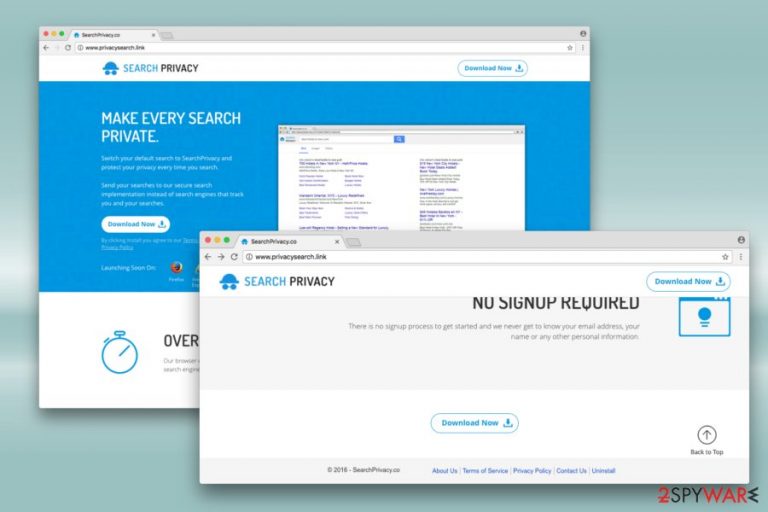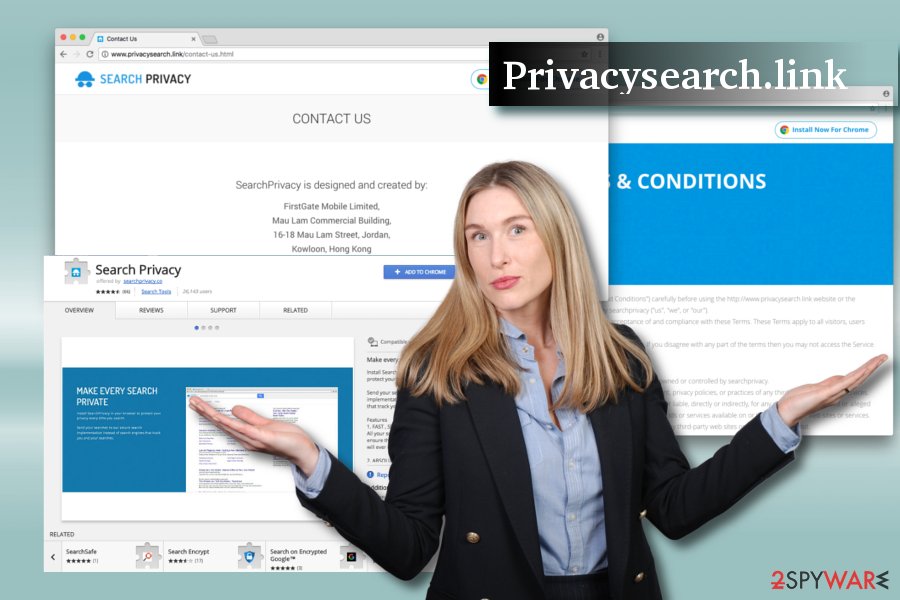Privacysearch.link (Chrome, Firefox, IE, Edge) - Simple Removal Guide
Privacysearch.link Removal Guide
What is Privacysearch.link?
Privacysearch.link – a browser hijacker that you should not use to increase your privacy

Privacysearch.link (alternatively known as Search Privacy) is a fake search engine which promises you to “protect your privacy while you search the web by providing quality search results.” However, Search Privacy virus is considered to be a browser hijacker which sets your homepage and search engine to http://www.privacysearch.link/spsearch/?q= automatically.
This browser hijacker might seem like a useful application which can help you browse the web anonymously, without any information collected by third parties. According to its download page, Privacysearch.link promises the following:
- Fast, secure and encrypted;
- No search filtering;
- No search leakage.
However, everything becomes clear once you start reading Terms of Service and Privacy Policy. Data which is collected by Privacysearch.link virus include victim's IP addresses, search terms, ads/web results clicked, search preferences, etc. As you can see, this search engine has nothing in common with privacy, and you should waste no time to uninstall it from your computer.
Such non-personally identifiable information[1] is usually collected to gain revenue by conducting research on users' browsing habits and selling this information to third-parties. This behavior is extremely deceptive as there is no guarantee that the following data won't be given to cyber criminals and similar dishonest people. The only way to stop it is to remove Privacysearch.link from the system.
You might not notice that your computer was hijacked right after turning on your computer as this is typically initiated behind user's back. Nevertheless, you will see it as soon as you launch your Google Chrome, Internet Explorer, MS Edge, Mozilla Firefox or another browser.
Don't wait until its potentially dangerous redirects show up on your computer and get rid of this virus. However, sometimes it might be a more complicated task than it seems. To make it easier, use FortectIntego to help you with Privacysearch.link removal. Additionally, you can check our manual removal tutorial below.

Dubious applications are mostly spread with bundling
Despite the fact that this application has an official homepage and is offered in Chrome store, the most common distribution method used to spread it is quite ambiguous. More often, potentially unwanted programs are installed on the system by bundling. This deceptive marketing campaign is considered to be legal, no matter how crooked and unfair it might seem.
Everyone is trying to save time and internet surfers are not an exception. However, we can assure you that investing time in proper software installation is beneficial. Therefore, when installing the free software you obtained online, please never:
- Click “Next” button several times without looking at statements you agree with;
- Use Recommended/Quick settings to get the program you need faster;
- Rush through installation steps.
Instead, make sure you opt for Custom or Advanced installation mode and uncheck all pre-checked check marks that allow installation of suspicious add-ons, extensions, keygens,[2] search engines and similar components.
Removal of PUPs can save you from Privacysearch.link redirects
Privacysearch.link removal is your only option if you want to keep your computer redirect-free. We can assure you that this app will not improve your privacy on the Internet, so it would be better to get rid of it without wasting time. You have two methods to do that: manual and automatic.
If you would like to remove Privacysearch.link virus from your computer manually, you should follow our step-by-step guide below. In the beginning, this tutorial might seem quite complicated, as there are many steps to go through. However, just be patient and follow every step attentively and you will fix your computer.
If you decide to go with automatic elimination, you have to download and install one of the anti-malware tools that are given in the following list. If you decided to choose something from the Internet, be aware that there is a countless number of fake applications and anti-virus programs offered online. Instead of deleting malware, these programs might infect your PC with other viruses, so make sure you select genuine software.
You may remove virus damage with a help of FortectIntego. SpyHunter 5Combo Cleaner and Malwarebytes are recommended to detect potentially unwanted programs and viruses with all their files and registry entries that are related to them.
Getting rid of Privacysearch.link. Follow these steps
Uninstall from Windows
To uninstall Privacysearch.link, use Control Panel. You should get rid of every suspicious app and eliminate programs that you can't remember installing on your computer.
Instructions for Windows 10/8 machines:
- Enter Control Panel into Windows search box and hit Enter or click on the search result.
- Under Programs, select Uninstall a program.

- From the list, find the entry of the suspicious program.
- Right-click on the application and select Uninstall.
- If User Account Control shows up, click Yes.
- Wait till uninstallation process is complete and click OK.

If you are Windows 7/XP user, proceed with the following instructions:
- Click on Windows Start > Control Panel located on the right pane (if you are Windows XP user, click on Add/Remove Programs).
- In Control Panel, select Programs > Uninstall a program.

- Pick the unwanted application by clicking on it once.
- At the top, click Uninstall/Change.
- In the confirmation prompt, pick Yes.
- Click OK once the removal process is finished.
Delete from macOS
Remove items from Applications folder:
- From the menu bar, select Go > Applications.
- In the Applications folder, look for all related entries.
- Click on the app and drag it to Trash (or right-click and pick Move to Trash)

To fully remove an unwanted app, you need to access Application Support, LaunchAgents, and LaunchDaemons folders and delete relevant files:
- Select Go > Go to Folder.
- Enter /Library/Application Support and click Go or press Enter.
- In the Application Support folder, look for any dubious entries and then delete them.
- Now enter /Library/LaunchAgents and /Library/LaunchDaemons folders the same way and terminate all the related .plist files.

Remove from Microsoft Edge
Delete unwanted extensions from MS Edge:
- Select Menu (three horizontal dots at the top-right of the browser window) and pick Extensions.
- From the list, pick the extension and click on the Gear icon.
- Click on Uninstall at the bottom.

Clear cookies and other browser data:
- Click on the Menu (three horizontal dots at the top-right of the browser window) and select Privacy & security.
- Under Clear browsing data, pick Choose what to clear.
- Select everything (apart from passwords, although you might want to include Media licenses as well, if applicable) and click on Clear.

Restore new tab and homepage settings:
- Click the menu icon and choose Settings.
- Then find On startup section.
- Click Disable if you found any suspicious domain.
Reset MS Edge if the above steps did not work:
- Press on Ctrl + Shift + Esc to open Task Manager.
- Click on More details arrow at the bottom of the window.
- Select Details tab.
- Now scroll down and locate every entry with Microsoft Edge name in it. Right-click on each of them and select End Task to stop MS Edge from running.

If this solution failed to help you, you need to use an advanced Edge reset method. Note that you need to backup your data before proceeding.
- Find the following folder on your computer: C:\\Users\\%username%\\AppData\\Local\\Packages\\Microsoft.MicrosoftEdge_8wekyb3d8bbwe.
- Press Ctrl + A on your keyboard to select all folders.
- Right-click on them and pick Delete

- Now right-click on the Start button and pick Windows PowerShell (Admin).
- When the new window opens, copy and paste the following command, and then press Enter:
Get-AppXPackage -AllUsers -Name Microsoft.MicrosoftEdge | Foreach {Add-AppxPackage -DisableDevelopmentMode -Register “$($_.InstallLocation)\\AppXManifest.xml” -Verbose

Instructions for Chromium-based Edge
Delete extensions from MS Edge (Chromium):
- Open Edge and click select Settings > Extensions.
- Delete unwanted extensions by clicking Remove.

Clear cache and site data:
- Click on Menu and go to Settings.
- Select Privacy, search and services.
- Under Clear browsing data, pick Choose what to clear.
- Under Time range, pick All time.
- Select Clear now.

Reset Chromium-based MS Edge:
- Click on Menu and select Settings.
- On the left side, pick Reset settings.
- Select Restore settings to their default values.
- Confirm with Reset.

Remove from Mozilla Firefox (FF)
Remove dangerous extensions:
- Open Mozilla Firefox browser and click on the Menu (three horizontal lines at the top-right of the window).
- Select Add-ons.
- In here, select unwanted plugin and click Remove.

Reset the homepage:
- Click three horizontal lines at the top right corner to open the menu.
- Choose Options.
- Under Home options, enter your preferred site that will open every time you newly open the Mozilla Firefox.
Clear cookies and site data:
- Click Menu and pick Settings.
- Go to Privacy & Security section.
- Scroll down to locate Cookies and Site Data.
- Click on Clear Data…
- Select Cookies and Site Data, as well as Cached Web Content and press Clear.

Reset Mozilla Firefox
If clearing the browser as explained above did not help, reset Mozilla Firefox:
- Open Mozilla Firefox browser and click the Menu.
- Go to Help and then choose Troubleshooting Information.

- Under Give Firefox a tune up section, click on Refresh Firefox…
- Once the pop-up shows up, confirm the action by pressing on Refresh Firefox.

Remove from Google Chrome
Delete malicious extensions from Google Chrome:
- Open Google Chrome, click on the Menu (three vertical dots at the top-right corner) and select More tools > Extensions.
- In the newly opened window, you will see all the installed extensions. Uninstall all the suspicious plugins that might be related to the unwanted program by clicking Remove.

Clear cache and web data from Chrome:
- Click on Menu and pick Settings.
- Under Privacy and security, select Clear browsing data.
- Select Browsing history, Cookies and other site data, as well as Cached images and files.
- Click Clear data.

Change your homepage:
- Click menu and choose Settings.
- Look for a suspicious site in the On startup section.
- Click on Open a specific or set of pages and click on three dots to find the Remove option.
Reset Google Chrome:
If the previous methods did not help you, reset Google Chrome to eliminate all the unwanted components:
- Click on Menu and select Settings.
- In the Settings, scroll down and click Advanced.
- Scroll down and locate Reset and clean up section.
- Now click Restore settings to their original defaults.
- Confirm with Reset settings.

Delete from Safari
Remove unwanted extensions from Safari:
- Click Safari > Preferences…
- In the new window, pick Extensions.
- Select the unwanted extension and select Uninstall.

Clear cookies and other website data from Safari:
- Click Safari > Clear History…
- From the drop-down menu under Clear, pick all history.
- Confirm with Clear History.

Reset Safari if the above-mentioned steps did not help you:
- Click Safari > Preferences…
- Go to Advanced tab.
- Tick the Show Develop menu in menu bar.
- From the menu bar, click Develop, and then select Empty Caches.

After uninstalling this potentially unwanted program (PUP) and fixing each of your web browsers, we recommend you to scan your PC system with a reputable anti-spyware. This will help you to get rid of Privacysearch.link registry traces and will also identify related parasites or possible malware infections on your computer. For that you can use our top-rated malware remover: FortectIntego, SpyHunter 5Combo Cleaner or Malwarebytes.
How to prevent from getting stealing programs
Protect your privacy – employ a VPN
There are several ways how to make your online time more private – you can access an incognito tab. However, there is no secret that even in this mode, you are tracked for advertising purposes. There is a way to add an extra layer of protection and create a completely anonymous web browsing practice with the help of Private Internet Access VPN. This software reroutes traffic through different servers, thus leaving your IP address and geolocation in disguise. Besides, it is based on a strict no-log policy, meaning that no data will be recorded, leaked, and available for both first and third parties. The combination of a secure web browser and Private Internet Access VPN will let you browse the Internet without a feeling of being spied or targeted by criminals.
No backups? No problem. Use a data recovery tool
If you wonder how data loss can occur, you should not look any further for answers – human errors, malware attacks, hardware failures, power cuts, natural disasters, or even simple negligence. In some cases, lost files are extremely important, and many straight out panic when such an unfortunate course of events happen. Due to this, you should always ensure that you prepare proper data backups on a regular basis.
If you were caught by surprise and did not have any backups to restore your files from, not everything is lost. Data Recovery Pro is one of the leading file recovery solutions you can find on the market – it is likely to restore even lost emails or data located on an external device.
- ^ Michael Sweeney, Karolina Lubowicka. What Is PII, non-PII, and Personal Data?. Piwik Pro.
- ^ What is Keygen?. Wikipedia, the free encyclopedia.
